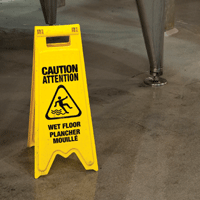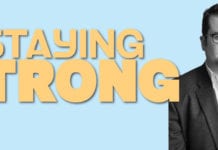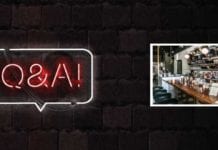Restaurant work presents staff and employers with a unique set of hazards, to life, limb and the bottom line
Cooks wear them like badges of honour — battle scars, the burns and cuts. Each one tells a story of an insanely busy service, a stupid mistake made by an over-tired chef or dishwasher, or just the unavoidable sensation of spitting bacon fat on your arm at brunch. Cooks are burned every day; it’s an accepted part of the job. As is the odd cut. Most kitchen folk are gonzo enough to take the hit and proudly soldier on.
Front of house can be fraught with danger, too. Hot coffee spills, inexperienced or distracted knife handlers cutting hundreds of lemon wedges or shucking oysters, malfunctioning espresso machines, and delicate wine glasses that shatter mid-polish; danger always lurks. When an accident is bad, the injuries can be serious, even life threatening — causing chaos, an interruption of service, and sometimes involvement from the police, government occupational safety inspectors and insurance professionals. The latter are visitors you don’t want in your establishment.
But there are ways to prevent avoidable mishaps; whether it’s through training, the right footgear, clear communication — “Behind!” — and time management. Many accidents happen because someone is rushing or sleep deprived.
As a champion oyster shucker, Patrick McMurray, owner of Starfish and Ceili Cottage, both in Toronto, has run himself through more than once with his oyster knife. “It happens when I take my eye off the oyster.”
And at a raw seafood bar there are some very surprising dangers: unique bacteria, jagged shell edges and poisonous creatures. “The first time I was opening live urchins I started feeling wobbly in my knees,” says McMurray. “I was being pricked by the spines and poisoned with a neuro-toxin! Then I learned the right way to do it.”
With the trend of nose-to-tail eating taking hold across Canada, there’s much more whole-animal butchery going on in the tight confines of restaurant kitchens, often by cooks with perhaps little butchery training. Breaking down a whole carcass is a dangerous job. Who doesn’t know a butcher or sausage maker with a missing finger or two?
With so many young, sometimes inexperienced chefs eagerly wielding boning and filleting knives, what are some of the best ways to keep the workplace safe? Open since February 2010, Churcut Roast House in Calgary is breaking down a least one whole hog and lamb each week, and chef and co-owner of, Connie DeSousa, believes proper knife care is paramount.
“A dull knife is the surest way to get badly cut, because you have to exert more pressure and you’re more inclined to slip suddenly. I train my cooks to sharpen their knives every week and hone them every time we cut.”
She also cites all the usual suspects: spills, rushing, not being mindful and not communicating well, and adds that understanding the anatomy of the animal is very important, too. “If you know the cuts well — beef, pork, lamb — you’ll see that there are parts that don’t need a knife at all; you can pull some muscles apart. That’s the safest way to go.”
It’s important to teach safety right from the get go. Chef Instructor Jason Mallette of Liason College’s Hamilton campus lists the top skills necessary for preventing accidents in the kitchen. “It really comes down to attitudes, proper attire and habits.”
With 10 campuses across Ontario, Liaison College graduates hundreds of chefs into the job market every year, and while there are no individual professors or classes dedicated solely to teaching accident prevention, the subject is an integral part of the curriculum. Mallette, a former Master Bombardier in the Royal Canadian Artillery, makes it a priority to drill into his students the need for cleanliness, communication, organization, mutual respect, professionalism, and how to anticipate what your co-worker might be doing next. “You need good mojo in the kitchen,” he exclaims. “It’s very important to keep the floors clean and free of spills,” he adds, “and if you do spill something and you can’t clean it up right away, let everybody else know. Communicate.”
Likewise, if a cook is walking with a knife or hot pan, they should shout it out, says Mallette: “‘hot pan coming through’ or ‘Behind with a knife!’”
As for the importance of proper uniform, Mallette insists, perhaps controversially, that the traditional chef’s clog is an accident waiting to happen — take that Molto Mario! He tells his students a tight-fitting, lace-up, non-skid shoe is the best.
Another aspect of kitchen safety is to know the equipment; learn how it works. Never use a tool you’re unfamiliar with and always unplug it before you clean it. According to chef Mallette, “Cuts are a daily occurrence. It’s unavoidable.” But one student recently lost a bit of finger by cleaning the blade of an immersion blender while the tool was still plugged in. Another lesson learned — the painful way.
With an army of full- and part-time employees in more than 60 countries, Compass Group runs kitchens on drilling platforms in the Gulf of Mexico, prison cafeterias, and fine-dining restaurants, such as C5 at Toronto’s Royal Ontario Museum. And since there are so many employees in such diverse kitchen environments across the globe, safety is always top of mind. Senior director of Risk Management, Dagmar Wilhelm, is passionate about worker safety and knows how to make it happen. “There must be top management commitment, and there must be a safety plan in place that meets internationally recognized standards.”
Wilhelm echoes Mallette regarding the main hazards, but has a few dangerous pratfalls of her own to add: sprains and strains; being caught in, struck by or struck against big machinery; exposure to extreme temperatures or noxious cleaning chemicals, as well as motor vehicle accidents. To counter all the risks, Wilhelm insists on conducting regular hazard and job-safety analysis, safe operating manuals for all equipment, and thorough job training, from pre-employment to ongoing sessions.
And to ensure the proper procedures are being followed rigorously at all times, Compass Group brings in additional experts, working with a third-party safety auditing company to ensure all the safety bases are covered. Inspectors make annual unannounced visits and file reports citing any violations or shortcomings, and advising on ways to improve. But, she adds, “It all starts with hiring the right people.”
And, yes, though all of this is for the workers’ safety, it’s also about protecting the bottom line. The impact of a bad accident, says Wilhelm, is like an iceberg, “There is the direct cost — sick leave, medical expenses — but that’s just the tip. The indirect costs — loss of public goodwill, partner and client confidence, potential loss of endorsements, rise in insurance premiums, damage to equipment, lost production, overtime — this is what you don’t see, and it can be six to nine times more than the direct cost.”
Seems Mother was right — an ounce of prevention is worth a pound of cure.





















